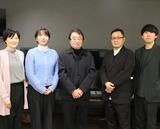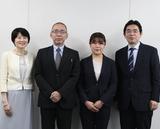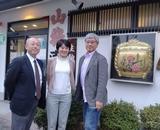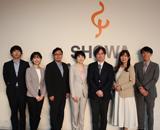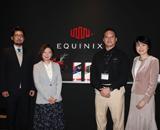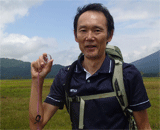March 2016
Diamond Harvard Business Review: Contributions to Leaders Determined to Change the World
Harvard Business Review (hereinafter referred to as "HBR") is a management magazine that is read the world over: in addition to the 290,000 of subscribed executives in the United States, it is enjoyed by 600,000 business leaders and professionals throughout twelve countries, including Japan, Germany, Italy, BRICS and the largest South American states.
Since its foundation in 2005, Arc Communications has helped translate the Japanese version of the Diamond Harvard Business Review ("DHBR").
For this in-depth interview, DHBR editor-in-chief, Fumio Iwasa, and Akiko Kogure shed a new light on their leading expertise, and on the art of compiling a magazine which is a consistent source of inspiration to global leaders.
From left to right: Saito, Kogure, Iwasa and Ohsato
- Profile
- Fumio Iwasa: Entered Diamond, Inc. in 2000. Editor-in-chief of Diamond Harvard Business Review since 2012.
- Akiko Kogure: Diamond Harvard Business Review, Diamond, Inc.
- Mariko Ohsato: CEO & President, Arc Communications Inc.
- Manami Saito: Translation and Localization Chief Project Manager, Arc Communications Inc.
DHBR's Target Audience: Leaders Who Are Determined to Change the World
Ohsato: HBR and DHBR are read and studied religiously by business school graduates, but could you briefly present them to our readers who might not be familiar with them?
Iwasa: DHBR is an integrated management magazine and the Japanese version of HBR. The latter is a publication issued by America's Harvard Business School, and will be celebrating its 40th anniversary in 2016.
The very first issue of HBR came out in 1922, and the magazine is now published and translated in no less than twelve countries. Launched in 1976, DHBR is the first of these translated versions; it was initially published bimonthly, but later became a monthly magazine after its relaunch in October 2000. I might also add that Harvard Business School, the parent body, is the oldest business school in the world and the place where Masters of Business Administration (MBA) originated.
Since the magazine is produced by a management graduate school with such high authority, it is regarded as a high quality magazine read by executives the world over.
Ohsato: So one could say that the bulk of your readership is made up of executives, then?
Iwasa: Large company executives and highly placed personnel constitute half of our readership, while the other half is made of people in their thirties/early forties who are working their way toward the managerial class. DHBR is also read by many NPO representatives.
So we tend to consider that our readers - mainly from managerial classes - are leaders who are determined to change society.
Ohsato: Your editorial department produces top quality issues on a monthly basis, could you tell us more about its structure?
Iwasa: We are a team of five in the editorial department. There is Ms. Kogure - who has a longer experience at DHBR than myself -, then three editors, respectively in their twenties, thirties and forties.
None of us are MBA holders. So we learn about the concerns of the managerial class through interviews based on which we endeavor to understand what does - and does not - make an impression on them. Then, we share our ideas within the editorial team.
Still, a magazine editor's work basically consists in choosing projects, and assigning them to professionals in the relevant fields. The translation aspect accounts for 60% of the magazine, and we rely on translators such as yourselves at Arc Communications. Another facet we attach great value to is keeping a unified visual identity, so we have worked with the same designer since adopting the new monthly formula.
For the rest, we work with external parties - writers, proofreaders, photographers and printing companies - on every issue.
An Unwavering Editorial Line and Evolving with the Times
Ohsato: Since starting our collaboration with DGBR, we have worked with three editors-in-chief including yourself, Mr. Iwasa, and I feel that a change at the top of the editorial team alters the general feel of the magazine. Could you tell us more about your current editorial line?
Iwasa: DHBR's basic editorial line has never changed: "contributing to superior leadership" and "producing an integrated management magazine for global leaders in the making". However, the magazine does indeed evolve according to three factors: current demand, the transformations of the original HBR, and the strengths and interests of the editor-in-chief.
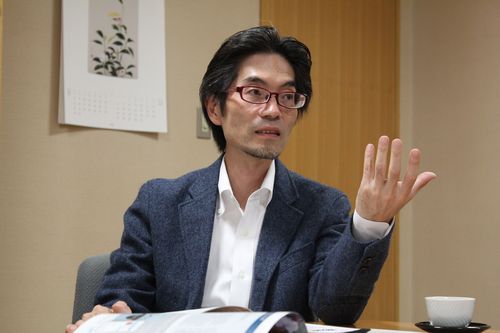
Ohsato: I remember a time when DHBR almost entirely consisted of HBR article translations, so I feel that there has been a sensible increase in Japanese-exclusive contents since Mr. Iwasa was appointed editor-in-chief.
Kogure: Yes, indeed. The stance of Mr. Iwasaki, the previous editor-in-chief, was to give our readers a comprehensive presentation of Harvard's cutting-edge essays. Having worked with both of them, I feel that Mr. Iwasa has brought more of a distinctively Japanese hue to our magazine.
Iwasa: When I became editor-in-chief, the concept I had in mind was to provide articles that struck home with DHBR readers. To achieve this effect, we increased the quantity of Japanese-exclusive contents so as to make the messages brought forth by Harvard easier to identify with and react to.
Moreover, I like interview articles. I keep a mental list of all the people I would like to see appear in our pages and, thankfully, we have never been turned down by anybody we approached. One might say we are using the brand name established by our predecessors since 1976 to conduct interviews to our heart's content. (Laughs)
Ohsato: You have never been turned down? You have no idea how envious I am! Incidentally, every time I receive my new issue of DHBR, before anything else, I check the upcoming issue's themes.
Iwasa: You're probably the only one who reads DHBR that way. (Laughs)
Ohsato: How do you decide on a theme for each issue?
Iwasa: We start by taking a look at HBR's contents. For instance, for the June 2015 issue, HBR had compiled a special edition on artificial intelligence. We thought that topic needed to reach Japan, so we combined it with original contents, interview articles, and made a special edition out of it.
On the other hand, there are also main feature that we feel won't be of much appeal to our Japanese audience. In such cases, we sometimes take apart HBR's main feature and combine parts of it with past essays to come up with a new, original theme.
Actually, this is one of the most crucial parts of an editor's work: we read the essays translated by Arc Communications and other language solution providers, suggest ideas of what might be interesting to use as a special feature, and then repeat the process on a daily basis during our editorial meetings.
Feature Interview Index

